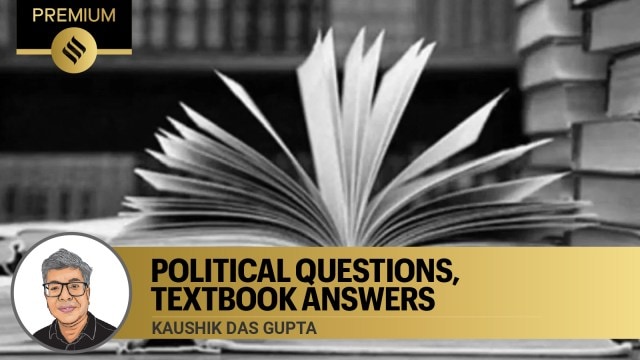
Dear Readers,
Revision of social science textbooks, especially history readers, has become par for the course. Most times, this exercise is not guided by the scholarly imperative to mirror developments in knowledge. Instead, it seems to bear the ideological hallmarks of those in power. Textbooks have borne this burden for long. However, there’s a difference in today’s restructuring of reading material compared to schoolbook rewriting exercises of the past.
In the last five years, parts of history textbooks have been either excised or modified, and the changes have been ascribed to a variety of factors – from rationalising content to reducing the burden on students. These exercises claim to be motivated by a desire to ensure student “well-being”, but carry imprints of the ruling regime’s anxiety to flatten social complexities.
Introduced last week, the latest changes, dotted with references to the “brutality” of medieval Muslim kings, carry a disclaimer, ‘Notes on Some Darker Periods of History’. It says: “No one should be held responsible today for events of the past. The emphasis is on an honest approach to history with a view to drawing important lessons for a better future.” Historians have rightly underlined that the account is not as “honest” as it claims. The selective references to the destruction of places of worship by Muslim kings have not gone unnoticed. Scholars have rightly pointed out that such violence was not uncommon across a variety of regimes in ancient and medieval times.
These are significant interventions. Yet, there is a broader challenge for historians: To underline the fundamental differences between the social and moral universe of pre-modern times and today’s norms. Kings and sultans were not accountable for their actions, statecraft had very different objectives and wars were often critical to empire-building. All this is historical common sense. However, it’s yet to become general common sense. Narratives of the pre-modern era continue to be framed around heroes and villains. The search for a protonationalist in Ashoka, Akbar, Shivaji or Tipu Sultan – depending on ideological inclination – and describing a Mahmud of Ghazni or Allaudin Khalji or Aurangzeb as evil might seem somewhat different endeavours. But both obscure an understanding of epochs, much removed in time – Mahmud of Ghazini lived in the 10th-11th centuries, the Khaljis in the 13th and 14th centuries, and the last great Mughal ruled from 1658-1707. That the latest revisions in textbooks bracket a more than 500-year period under the shibboleth of “Dark Age” shows that even a section of historians – affiliated to the ruling regime – carry such blinkers.
The challenge, in large measure, has to do with a historiographical deficit, plugging which remains a work in progress. Indian historians have produced groundbreaking studies on the extractive nature of medieval kingdoms, the ebbs and flows of commerce, the caste system and rise of kingdoms far away from sultanates in Delhi. Yet, an understanding of violence in pre-modern times is a relatively recent historiographical pursuit. Charges of destruction of places of worship continue to be countered by narratives which stress the political impulses behind such violence – as opposed to religious motives. The standard response also is that instances of destruction of places of worship by sultans and badshahs were far fewer, compared to the grants they gave to temples and monasteries. A historian should, of course, be judged by her fealty to facts. Viewed from that perspective, there is nothing wrong in how most professional historians have responded to allegations of “brutality” levied on Muslim kings.
However, today the challenge in classrooms – and beyond – is not just to provide a point-by-point counter. The internet, political propaganda, social media, films and TV make lives information heavy. Whatsapp chats have precipitated the collapse of some of the traditional filters on information.
How can narratives that place violence in medieval times in their historical context help? Why do people need to understand the complexities of times when rulers could destroy some temples and give grants to many others? What purpose would it serve to depict Mughal and several other rulers as complex personalities who had the blood of their kin on their hands and yet presided over great cultural refinement? Why tell the stories of Shivaji’s successors who struck terror in people in Bengal or frame Tipu Sultan’s role in resisting the Britishers without underplaying the violence his forces meted out to some communities? Studies placing personalities in their times — and dissemination of such scholarship outside academia — are, of course, needed for purely epistemological purposes. History is at its most vigorous when it not only celebrates the resilience of societies but also tries to understand fault lines. The search for syncretism in medieval times was driven by a young nation’s desire to place a salve on the wounds of Partition as well as to counter the colonial historian’s charge that Indian history, before the arrival of the British, was nothing but an account of communal feuding. Histories of pre-modern violence, not prejudiced by colonial blinkers and innocent of sectarian agendas, have been few, and they have not gone beyond academia.
But why disturb the student’s “well-being” by introducing such complexities in textbooks? The latest changes have been introduced in Class VIII textbooks – a time when youngsters step into their teens. They are introduced to complicated concepts in mathematics and science – cell division, for instance. Why not in the social sciences? A textbook is perhaps the only text of history that a large majority of people, who do not engage with the discipline for professional purposes, will encounter in their lives – while they would be inundated with myriad accounts of the past. Critics of the revisions are, therefore, right in underlining the importance of rigour in reading materials. The task also is to find ways to communicate the complexity that informs their scholarship outside select circles – a difficult yet necessary imperative for the historian, inside and outside academia.
Till next time,
Kaushik